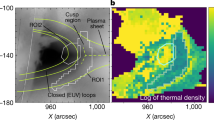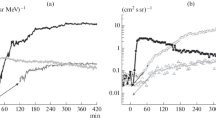Abstract
Some X-class flares (hot thermal flares, HTF) observed with the Hinotori satellite show unique behavior: slow time variability, a compact hard X-ray source containing dense (n > 1011 cm−3) and hot (T > 3 × 107 K) plasma, and unusually weak microwave emission in spite of the intense magnetic field (B > 330 G) required theoretically to sustain the hot plasma. These observations show that HTF's have essentially thermal characteristics throughout the flare evolution, while in impulsive flares, there is a transition in the energy release mode from particle acceleration (impulsive phase) to plasma heating (gradual phase). This behavior can be explained in a unified manner by employing parallel DC electric field acting over large distances.
Similar content being viewed by others
References
Bai, T., and Dennis, B. R.: 1985, Astrophys. J. 287, 179.
Dennis, B. R.: 1985, Solar Phys. 100, 465.
De Jager, C.: 1986, Space Sci. Rev. 44, 43.
Duijveman, A., Hoyng, P., and Machado, M. E.: 1983, Solar Phys. 81, 137.
Kai, K.: 1985a, Publ. Astron. Soc. Japan 37, 155.
Kai, K.: 1985b, Proc. Cosmic Radiation Symposium (ISAS, Tokyo), p 69.
Kawabata, K. Ogawa, H. and Suzuki, I.:1983, Solar Phys. 86, 247.
Kondo, I.: 1982, in Y. Tanaka et al. (eds.) Proc. Hinotori Symposium on Solar Flares (ISAS, Tokyo), p. 3.
Kundu, M and Woodgate, B (eds.): 1986, Energetic Phenomena on the Sun (NASA CP-2439), p. 2–19.
Lemmens, A. and De Jager, C.: 1986, Solar Phys. 106, 365.
Lin, R. P., Schwartz, R. A., Pelling, R. M., and Hurley, K.C.: 1981, Astrophys. J. (Letts.) 251, L109.
Lin, R. P., Schwartz, R. A.: 1987, Astrophys. J. 312, 462.
Machado, M. E., Duijveman, A., and Dennis, B. R.: 1982, Solar Phys. 79, 85.
Ogawara, Y: 1988, in these proceedings.
Sakurai, T.: 1983, Solar Phys. 86, 339.
Strong, K. T.: 1984, Solar Phys. 91, 325.
Tanaka, K., Watanabe, T., Nishi, K., and Akita, K.: 1982, Astrophys. J. (Letts.) 254, L59.
Tanaka, Y.: 1983, Solar Phys. 86, 3.
Tsuneta, S: 1984, in J.-C. Pecker and Y. Uchida (eds.) Proc. Japan-France Seminar on Active Phenomena in the Outer Atmospheres of Stars and the Sun, Paris p. 243.
Tsuneta, S. et. al.: 1984a, Astrophys. J. 280, 887.
Tsuneta, S. et. al.: 1984b, Astrophys. J. 284, 827.
Tsuneta, S.: 1985, Astrophys. J. 290, 353.
Author information
Authors and Affiliations
Rights and permissions
About this article
Cite this article
Tsuneta, S. Impulsive and hot thermal solar flares. Sol Phys 113, 35–48 (1987). https://doi.org/10.1007/BF00147680
Published:
Issue Date:
DOI: https://doi.org/10.1007/BF00147680




